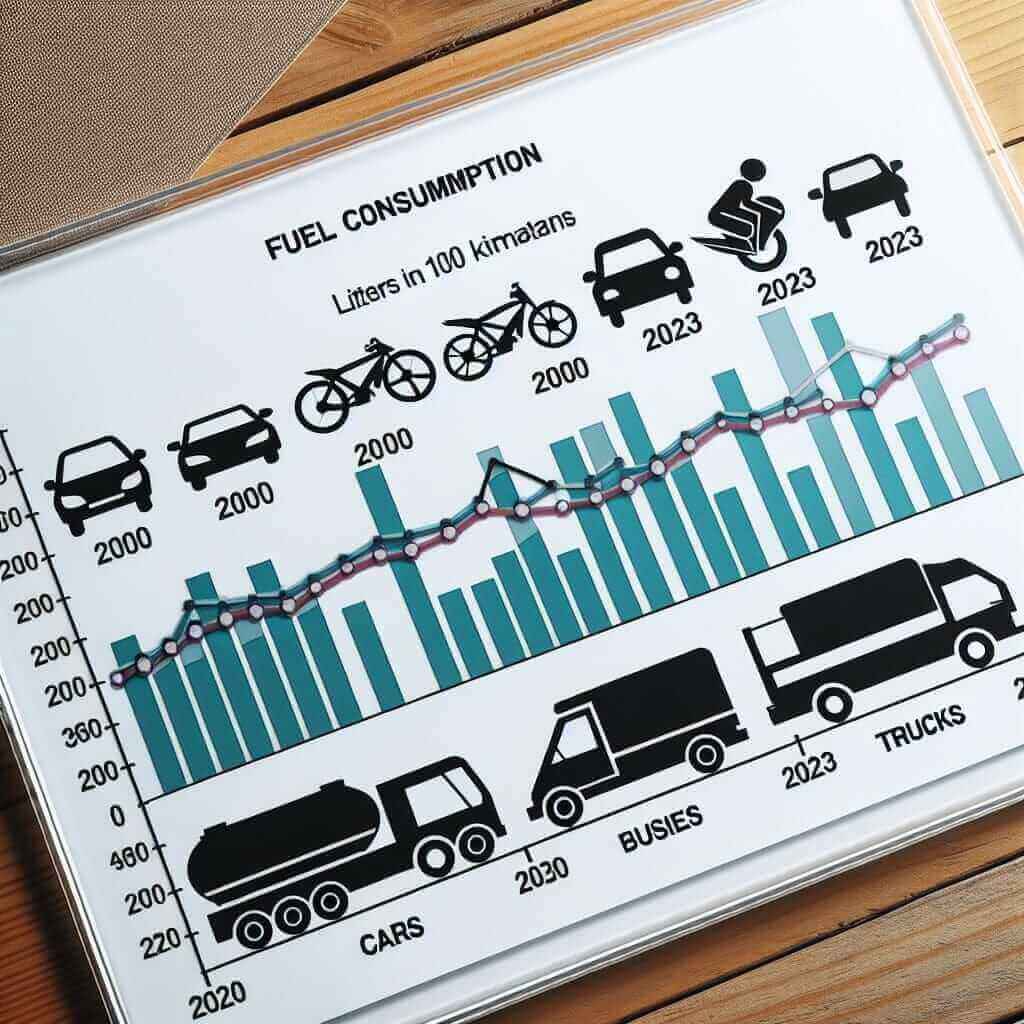In the IELTS Writing Task 1, you are often asked to describe data presented in various forms, such as charts, graphs, or tables. Today, we will examine a sample task related to fuel consumption by different types of vehicles from 2000 to 2023, aiming to help you achieve a high band score.
Understanding the Task
Sample Task
You should spend about 20 minutes on this task.
The table below shows the fuel consumption (in litres per 100 kilometres) of four different types of vehicles (cars, motorcycles, buses, and trucks) in three different years (2000, 2010, and 2023).
Summarise the information by selecting and reporting the main features, and make comparisons where relevant.
Write at least 150 words.
| Vehicle Type | 2000 | 2010 | 2023 |
|---|---|---|---|
| Car | 8.0 | 7.5 | 6.8 |
| Motorcycle | 5.5 | 4.8 | 4.2 |
| Bus | 25.0 | 20.0 | 18.5 |
| Truck | 30.0 | 28.0 | 25.0 |
Analysing the Task
Before diving into writing, let’s analyse the task:
- Identify Key Trends: Note the general trends over the years for each vehicle type.
- Highlight Comparisons: Make comparisons between the different vehicle types.
- Use Data Effectively: Mention specific figures to support your statements.

Writing the Sample
Introduction
Start with a brief introduction, paraphrasing the task statement.
Example:
The table illustrates the fuel consumption of four types of vehicles (cars, motorcycles, buses, and trucks) over three years (2000, 2010, and 2023).
Overview
Provide a general overview of the main trends observed.
Example:
Overall, it can be seen that all types of vehicles showed a decrease in fuel consumption over the years. Cars and motorcycles had the most significant reduction, while buses and trucks also followed a similar downward trend but at a slower pace.
Detailed Paragraphs
Describe the data in detail, split into logical paragraphs.
Example:
In 2000, cars consumed 8.0 litres per 100 kilometres, which decreased to 7.5 litres by 2010 and further to 6.8 litres by 2023. Similarly, motorcycles needed 5.5 litres in 2000, but this dropped to 4.8 litres in 2010 and then to 4.2 litres in 2023.
Buses and trucks, while more fuel-intensive, also showed improvements. In 2000, buses used 25.0 litres, which reduced to 20.0 litres by 2010 and 18.5 litres by 2023. Trucks had the highest consumption, starting at 30.0 litres in 2000, slightly decreasing to 28.0 litres in 2010 and 25.0 litres in 2023.
Key Vocabulary
- Fuel consumption (n) [fjuːl kənˈsʌmpʃən]: The amount of fuel used by a vehicle.
- Decrease (v) [ˈdiːkriːs]: To become less.
- Reduction (n) [rɪˈdʌkʃən]: The act of making something less.
- Fuel-efficient (adj) [ˌfjuːəl ɪˈfɪʃənt]: Using less fuel.
- Trend (n) [trɛnd]: A general direction in which something is developing or changing.
- Consumption (n) [kənˈsʌmpʃən]: The using up of a resource.
Grammar Points
- Comparative Structures: “decreased from 8.0 litres to 6.8 litres”
- Passive Voice: “was reduced by”
- Time Expressions: “over the years”, “by 2023”
Example Sentences:
- Cars became more fuel-efficient, decreasing their consumption from 8.0 litres to 6.8 litres.
- The consumption of buses and trucks was reduced significantly over the observed period.
- By 2023, fuel consumption had decreased to 4.2 litres for motorcycles.
Conclusion
Summarise the approach to ensure achieving Band 7+:
- Start with a clear introduction.
- Include an overall statement outlining main trends.
- Use specific data points to support your analysis.
- Employ advanced vocabulary and precise grammar structures.
By following this structured approach, you can effectively tackle similar tasks on the IELTS Writing exam, presenting well-organised and detailed responses that are likely to achieve a high score.